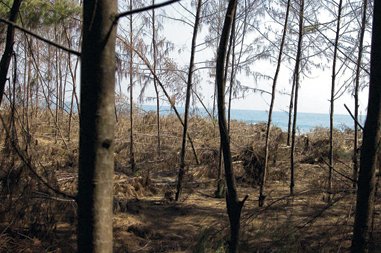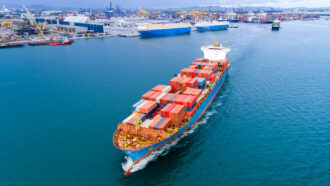Forests as a tsunami shield
Trees appear to protect seaside settlements from the worst effects of a tsunami.
By Emily Sohn
It’s been a banner year for natural disasters. Tsunamis and hurricanes, in particular, have battered homes, destroyed cities, and taken thousands of lives. Areas along the oceans have been slammed especially hard.
The news isn’t all gloom and doom, however. Scientists working along the southeastern coast of India have found that trees appear to protect seaside settlements from the worst effects of a tsunami.
 |
|
The December 2004 tsunami knocked down casuarina trees next to the Indian Ocean but left trees farther inland—and the villages behind them—standing.
|
| V. Selvam/Science |
When a massive tsunami swept through Asia last winter, it caused massive destruction. Villages surrounded by trees, however, suffered far less damage than did villages without protective forests.
Scientists have long suspected that mangroves (trees that grow in the water along the coast) protect the land nearby. To test this idea, ecologists started collecting data last Dec. 27, the day after the big tsunami struck.
They chose to focus on a 21-kilometer (13-mile) stretch of coast in Cuddalore, India. This stretch was perfect for the study because it was straight and uniform, so waves hit every part of it with about the same amount of force.
Other places were hit harder than Cuddalore, but the 4- to 5-meter (13- to 16-foot) waves that swept into Cuddalore were big enough to destroy two villages. Three other villages survived. The only difference was that the first two had no protective mangroves nearby, while the other three had hundreds of meters of mangroves between them and the ocean.
A few kilometers away, some other villages were surrounded by land-dwelling trees called casuarinas. The trees had been planted after a cyclone 20 years ago. These settlements survived, too, with little damage.
Healthy mangroves also emerged from the tsunami in much better shape than mangroves that had been harmed by people.
The research is important because mangrove forests have been disappearing. People use the wood and destroy the trees to make room for crops and create shrimp farms and fishponds.
Protecting and restoring the world’s coastal forests could be the secret to survival when future tsunamis strike.
Going Deeper:
Harder, Ben. 2005. Breaking waves: Mangroves shielded parts of coast from tsunami. Science News 168(Oct. 29):276-277. Available at http://www.sciencenews.org/articles/20051029/fob3.asp .
You can learn more about mangrove trees at www.epa.gov/owow/wetlands/types/mangrove.html (U.S. Environmental Protection Agency) and www.naturia.per.sg/buloh/plants/mangrove_trees.htm (Chek Jawa, Singapore).
Sohn, Emily. 2005. Unnatural disasters. Science News for Kids (Sept. 21). Available at http://www.sciencenewsforkids.org/articles/20050921/Feature1.asp .
______. 2005. Saving wetlands. Science News for Kids (April 6). Available at http://www.sciencenewsforkids.org/articles/20050406/Feature1.asp .
______. 2005. Wave of destruction. Science News for Kids (Jan. 19). Available at http://www.sciencenewsforkids.org/articles/20050119/Feature1.asp .
______. 2005. Digging into a tsunami disaster. Science News for Kids (Jan. 12). Available at http://www.sciencenewsforkids.org/articles/20050112/Note2.asp .
______. 2004. Recipe for a hurricane. Science News for Kids (Sept. 29). Available at http://www.sciencenewsforkids.org/articles/20040929/Feature1.asp .
______. 2004. An ocean view’s downside. Science News for Kids (March 31). Available at http://www.sciencenewsforkids.org/articles/20040331/Note2.asp .







